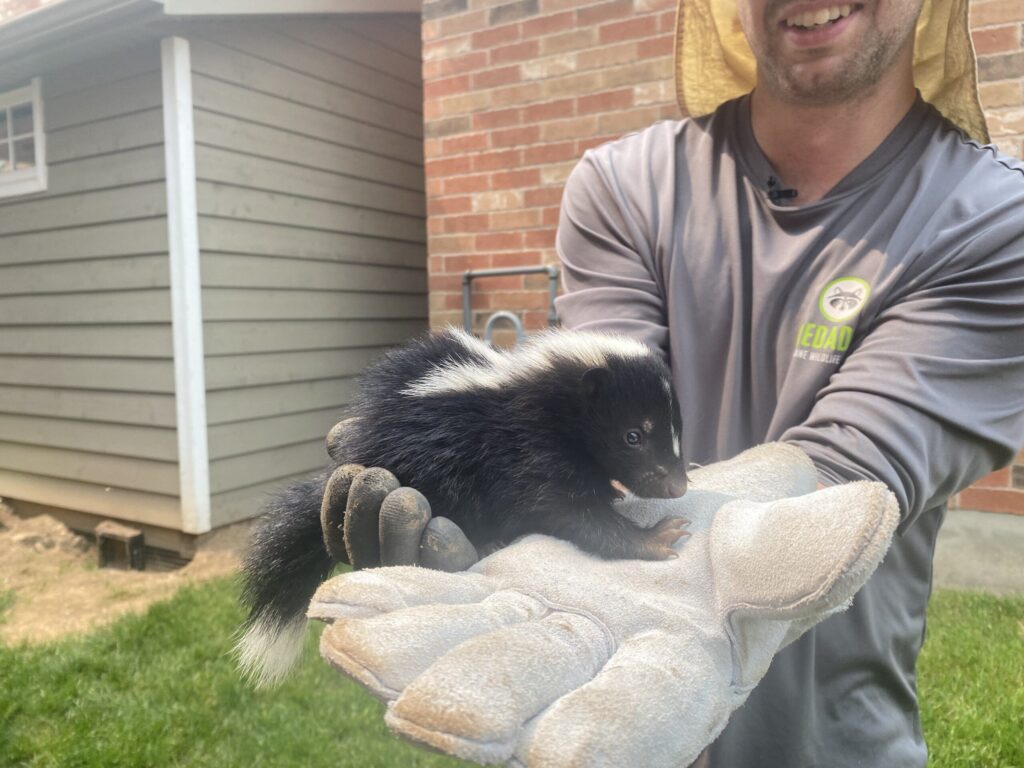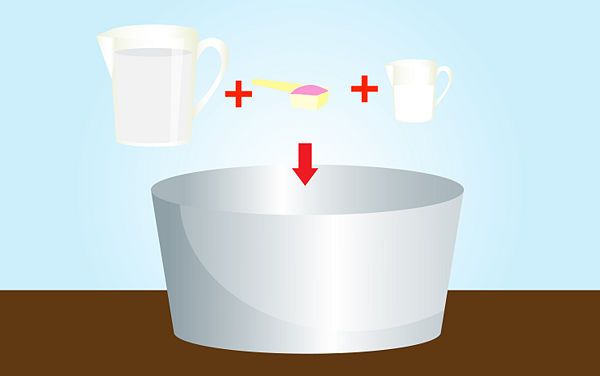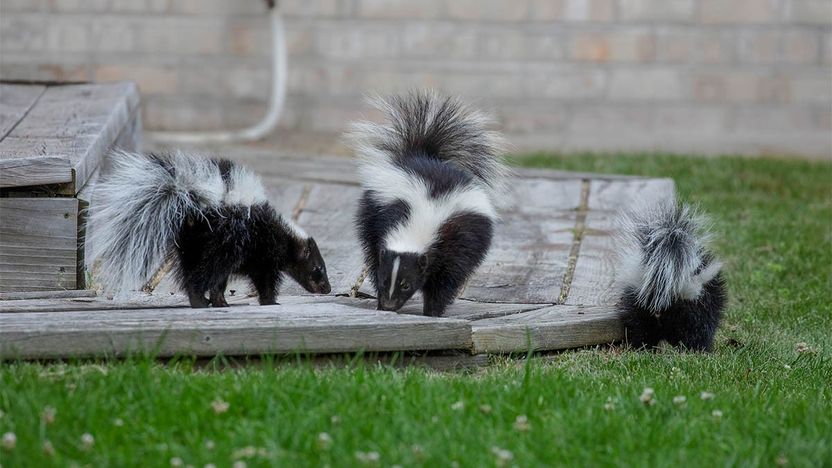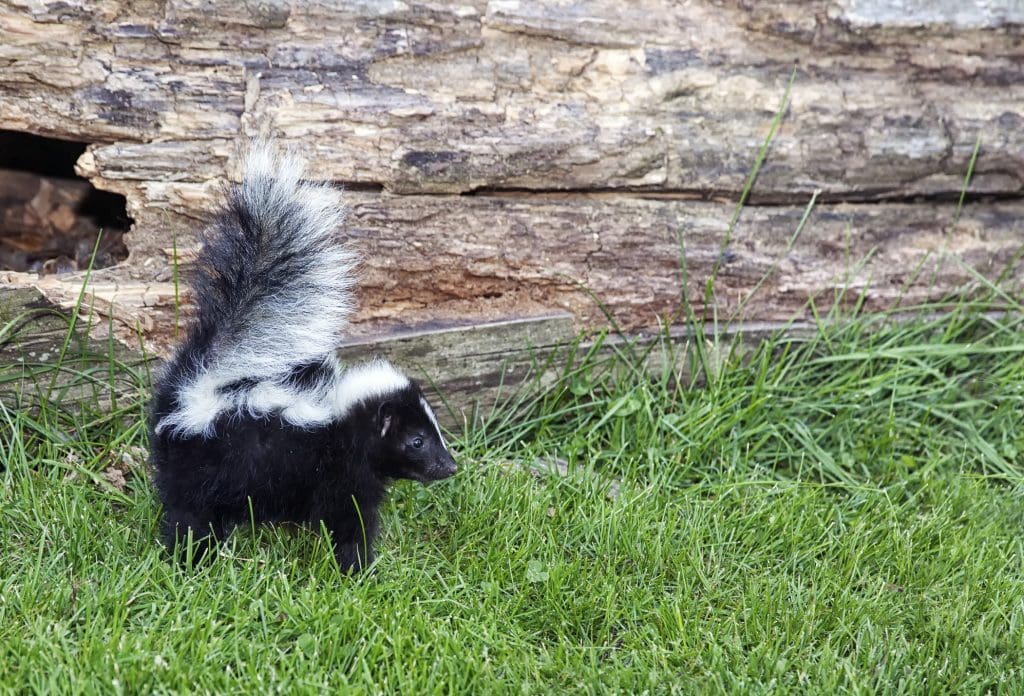Contents
Introduction:
Skunk odor infiltration into the home presents a unique olfactory challenge, requiring swift and effective measures for mitigation. The pungent scent, derived from the complex chemical composition of skunk spray, not only permeates the immediate surroundings but stubbornly persists, necessitating a comprehensive approach to eradication. This introduction aims to delve into the intricacies of skunk odor, emphasizing the urgency of addressing the issue promptly and exploring the multifaceted aspects of its elimination.
The chemical essence of skunk spray, primarily composed of volatile thiol compounds, creates an enduring and offensive aroma. Understanding the molecular structure of these compounds is crucial for formulating effective strategies to neutralize and eliminate the odor. Furthermore, the persistence of skunk odor demands immediate attention, as the longer it lingers, the more challenging it becomes to eradicate. The repercussions of a skunk’s visit extend beyond the immediate discomfort, impacting the affected items within the household and potentially causing long term damage.
Skunk smell in the house can originate from various sources, including direct encounters with skunks, inadvertent contact with contaminated items, or even the infiltration of the odor through open windows and doors. Recognizing these common sources is essential for devising targeted solutions that address the root cause of the issue. A nuanced understanding of the problem is fundamental to implementing effective and lasting remedies, ensuring a thorough elimination of the skunk odor from the living space.
Understanding Skunk Odor:
Skunk odor, an amalgamation of volatile thiol compounds, introduces a formidable challenge due to its complex chemical composition. These compounds, responsible for the distinct and enduring scent, demand a nuanced understanding for effective mitigation. Delving into the molecular structure of skunk spray provides insight into the nature of the odor and informs the selection of appropriate remedies. Recognizing that the composition of skunk spray is not only potent but also enduring, it underscores the importance of swift and strategic action to neutralize and eliminate the odor promptly.

The persistence of skunk odor poses a significant hurdle in its elimination. Unlike some other household odors, skunk smell tends to cling tenaciously to surfaces, requiring a comprehensive approach to ensure its complete eradication. Addressing this aspect of the problem is crucial for preventing long term discomfort and potential damage to personal belongings and household items.
Furthermore, the complexity of skunk odor extends beyond its chemical nature. The sources of skunk smell within the house can vary, ranging from direct encounters with skunks to secondary contamination through contact with affected items. Understanding these sources is pivotal in devising a targeted approach to neutralizing the odor at its origin. By identifying the pathways through which skunk smell infiltrates the home, individuals can tailor their strategies to effectively eliminate the source and prevent reoccurrence.
In navigating the intricate terrain of skunk odor, a holistic comprehension of its composition, persistence, and sources becomes the foundation for informed decision making. The subsequent sections will expound upon practical steps to take immediately following a skunk encounter, explore homemade remedies utilizing common household items, evaluate the efficacy of commercial odor neutralizers, and discuss the circumstances warranting professional cleaning services. This comprehensive exploration aims to empower individuals with the knowledge needed to tackle the multifaceted challenge of skunk odor and restore a fresh and odor free living space.
Immediate Steps to Take:
Upon the unwelcome infiltration of skunk odor into the home, immediate action is paramount to minimize its impact and prevent further diffusion. The following strategies aim to swiftly address the issue and lay the groundwork for subsequent odor elimination measures.
Ventilation:
- Opening windows and doors: Increase cross ventilation by opening doors and windows strategically, facilitating the dissipation of skunk odor.
- Using fans to circulate air: Employing fans aids in expediting the exchange of indoor and outdoor air, promoting a more rapid removal of the pungent scent.
Removal of Affected Items:
- Clothes and fabrics: Identify and segregate clothing and fabrics that have come into contact with skunk odor for immediate washing or treatment.
- Pet belongings: Attend to pet items, such as bedding and toys, to prevent lingering skunk odor on these possessions.
- Household items in close proximity: Evaluate and relocate items in the immediate vicinity that may have absorbed skunk odor, such as upholstery, curtains, and carpets.
Taking immediate steps to ventilate the space and remove affected items is foundational in mitigating the spread of skunk odor throughout the home. By expelling the odor laden air and isolating contaminated items, individuals set the stage for subsequent remediation efforts. These initial actions not only alleviate immediate discomfort but also contribute to the overall effectiveness of odor elimination strategies discussed in subsequent sections.
Homemade Remedies:
Empowering individuals with practical, homemade solutions, this section explores cost effective and readily available methods to combat skunk odor. These remedies leverage common household items, offering an effective alternative to commercially available products.

Vinegar Solution:
- Mixing ratio and application: Dilute white vinegar with water in a 1:1 ratio and apply the solution to affected areas. The acidic nature of vinegar helps neutralize skunk odor.
- Targeted areas for application: Direct the vinegar solution to specific surfaces, fabrics, or areas where skunk odor is concentrated, ensuring comprehensive coverage.
Baking Soda and Hydrogen Peroxide Mixture:
Preparation and application: Create a paste by combining baking soda, hydrogen peroxide, and a small amount of dish soap. Apply this mixture to affected surfaces, allowing it to sit before thorough rinsing.
Safety precautions: Exercise caution when handling hydrogen peroxide, wearing protective gear as needed, and ensuring proper ventilation during application.
Activated Charcoal:
Placement and duration: Position activated charcoal in bowls or pouches strategically around the affected areas to absorb skunk odor. Replace charcoal regularly for sustained effectiveness.
Absorption properties: Exploiting its porous nature, activated charcoal acts as a natural absorbent, drawing in and neutralizing skunk odor molecules.
These homemade remedies capitalize on the deodorizing properties of common household items, providing a practical and affordable means to counteract skunk odor. By incorporating these solutions into the odor elimination process, individuals can effectively address lingering scents and restore a more pleasant indoor environment.
Commercial Odor Neutralizers:
Navigating the array of commercial products designed for odor elimination, this section aims to provide insights into the options available, considerations for selection, and effective application techniques.
Overview of Available Products:
Explore a variety of commercial odor neutralizers, such as sprays, gels, and air purifiers, designed specifically for skunk odor elimination.
Consider products with enzymatic formulations, known for their efficacy in breaking down and neutralizing complex odor molecules.
How to Choose the Right Product:
- Assess the severity of skunk odor: Select products based on the intensity and spread of the odor within the home.
- Consider product reviews and testimonials: Gauge the effectiveness of different products by consulting user experiences and recommendations.
- Evaluate safety features: Prioritize products that are safe for indoor use, particularly in households with children and pets.

Application Techniques and Tips:
- Follow product instructions: Adhere to recommended application methods and usage guidelines provided by the manufacturer.
- Target specific areas: Direct the application towards areas with concentrated skunk odor, ensuring thorough coverage.
- Use in conjunction with other remedies: Combine commercial products with homemade solutions for a synergistic approach to odor elimination.
By exploring commercial odor neutralizers, individuals gain access to specialized formulations designed to tackle skunk odor effectively. The careful selection and application of these products can significantly contribute to a comprehensive strategy for eliminating lingering scents and restoring a fresh indoor atmosphere.
Professional Cleaning Services:
When skunk odor proves particularly stubborn or extensive, the engagement of professional cleaning services becomes a viable and efficient solution. This section explores the circumstances warranting professional intervention, considerations in selecting a service, and associated cost factors.
When to Consider Professional Help:
- Persistent odor despite DIY efforts: If skunk odor lingers despite rigorous home remedies, professional services may be necessary to address underlying issues.
- Extensive contamination: In cases where skunk spray has permeated building structures, ventilation systems, or inaccessible areas, professionals with specialized equipment may be required.
- Time sensitive situations: Professional services offer expedited solutions, crucial for individuals with time constraints or urgent odor removal needs.
Choosing a Reputable Cleaning Service:
- Research and reviews: Investigate potential cleaning services, considering online reviews, testimonials, and recommendations from trusted sources.
- Licensing and certification: Verify that the chosen service is licensed and certified to ensure adherence to industry standards and regulations.
- Specialization in odor removal: Opt for services with specific experience in skunk odor removal, showcasing their expertise in handling such challenges.
Cost Considerations:
- Obtain multiple quotes: Seek estimates from different professional cleaning services to compare costs and services offered.
- Inquire about comprehensive packages: Some services may offer bundled packages that include assessment, cleaning, and follow up, potentially providing cost savings.
Engaging professional cleaning services can be a strategic decision when faced with persistent or widespread skunk odor issues. By selecting a reputable service and weighing the associated costs, individuals can expedite the odor elimination process and ensure a thorough restoration of the indoor environment.
Preventive Measures:
Proactive measures play a crucial role in preventing future skunk encounters and subsequent odor infiltration into the home. This section explores strategies to deter skunks from the yard and outlines responsible pet management practices.

Skunk Deterrents for the Yard:
- Landscaping strategies: Trim vegetation and eliminate potential hiding spots to reduce skunk attractants. Install motion activated lights to deter nocturnal visits.
- Chemical repellents: Consider environmentally friendly repellents or natural deterrents, such as predator urine, strategically placed to discourage skunks from entering the yard.
Pet Management:
- Supervised outdoor activities: Keep pets under supervision, especially during dawn and dusk when skunks are more active. Promptly bring pets indoors if skunks are spotted nearby.
- Use of leashes and enclosures: Restrict pets to designated areas using leashes or enclosures, minimizing the chances of direct encounters with skunks.
Implementing preventive measures not only safeguards the home from potential skunk encounters but also mitigates the risk of recurring odor issues. By creating an inhospitable environment for skunks and managing pets responsibly, individuals can significantly reduce the likelihood of future skunk related challenges within the vicinity of their homes.
Additional Tips:
In addition to specific odor removal and preventive measures, adopting certain practices can enhance the overall efficacy of skunk odor management. This section offers supplementary tips for masking odors, maintaining regular cleaning routines, and addressing potential entry points.
Masking Odors with Pleasant Scents:
Utilize air fresheners and scented candles to temporarily mask skunk odors while comprehensive removal strategies are implemented.
Opt for natural deodorizers, such as citrus peels or essential oils, to infuse a fresh aroma into the living space.
Regular Cleaning Routines:
Establish and adhere to a consistent cleaning schedule, focusing on areas prone to odor absorption, such as carpets, upholstery, and curtains.
Incorporate odor neutralizing agents, like baking soda, into routine cleaning products to proactively combat lingering scents.
Monitoring and Addressing Potential Entry Points:
Inspect the exterior of the home for potential entry points that could allow skunks access. Seal gaps, cracks, and openings to prevent their intrusion.
Consider installing motion activated outdoor lighting near entry points to deter nocturnal visits.
By incorporating these additional tips into the overall approach to skunk odor management, individuals can enhance the effectiveness of their efforts and contribute to a sustained, odor free living environment. These practices complement the primary strategies discussed earlier, offering a holistic and proactive approach to addressing and preventing skunk related challenges.
Conclusion:
In conclusion, addressing skunk odor in the home demands a multifaceted and proactive approach to effectively eliminate the scent and prevent future occurrences. This comprehensive guide has explored the intricacies of skunk odor, from its chemical composition to the persistence of its scent, and provided practical strategies for immediate action and long term prevention.
Understanding the molecular structure of skunk spray and its enduring nature serves as the foundation for successful odor elimination. Immediate steps, such as ventilation and removal of affected items, mitigate the initial impact of skunk odor and set the stage for subsequent remediation efforts.
Homemade remedies, utilizing common household items like vinegar, baking soda, and activated charcoal, offer cost effective solutions for neutralizing skunk odor. Additionally, commercial odor neutralizers provide specialized formulations designed for efficient odor elimination, catering to varying levels of intensity.
When the situation requires professional intervention, engaging reputable cleaning services becomes essential. Choosing experienced professionals, considering reviews, and understanding cost factors contribute to a swift and effective resolution.
Preventive measures, including skunk deterrents for the yard and responsible pet management, play a crucial role in minimizing the risk of future skunk encounters and associated odors. These proactive strategies create an environment less conducive to skunk visits.
Supplementary tips for masking odors, maintaining regular cleaning routines, and addressing potential entry points provide additional layers of defense against skunk related challenges. Incorporating these practices into daily life enhances the overall efficacy of odor management.
In embracing a holistic approach that combines immediate actions, homemade remedies, commercial products, professional services, preventive measures, and supplementary tips, individuals can successfully combat skunk odor, restoring a fresh and pleasant atmosphere to their homes. Through diligence and a proactive mindset, the impact of skunk encounters can be minimized, ensuring a more comfortable and odor free living space.
